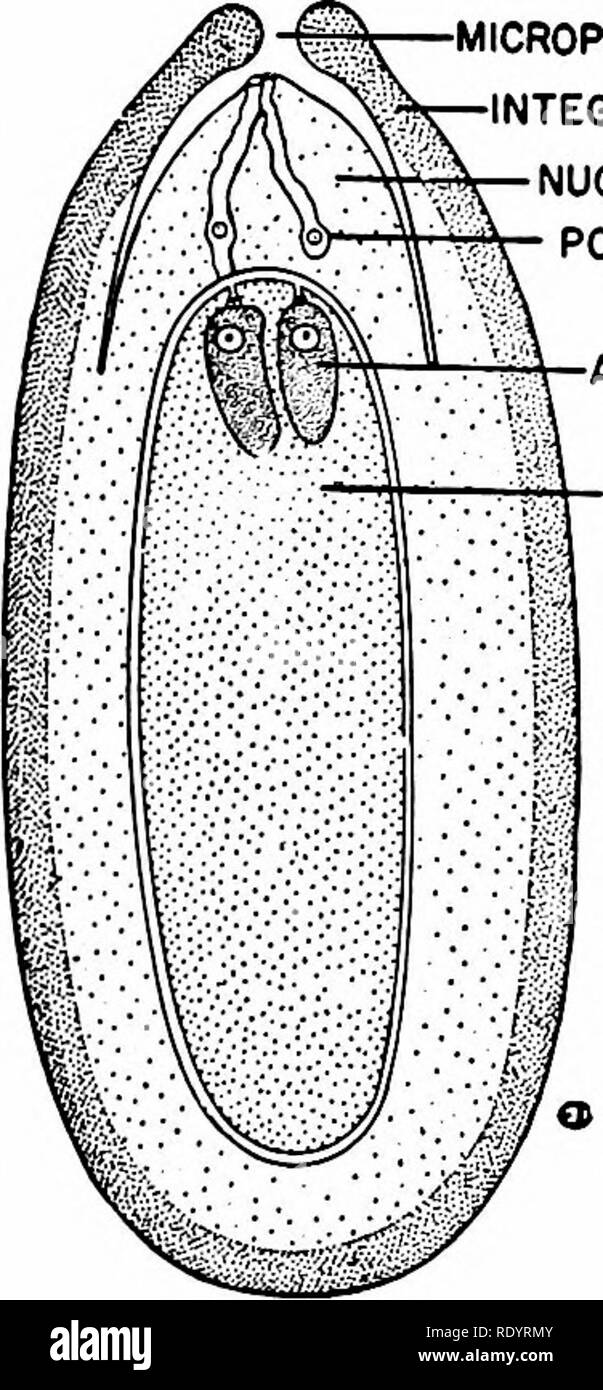. Principles of modern biology. Biology. MICROPYLE INTEGUMENT NUCELLUS POLLEN TUBE ARCHEGONIUM MEGAGAMETOPHYTE Fig. 31-26. Above, one scale (megasporophyll) of a pistillate pine cone, bearing two ovules. Be/ow, female gametophyte (megagametophyte) at center of a de- veloping ovule. Note the two male gametophytes (pol- len tubes), growing toward the egg cells, in the arche- gonia. The haploid gametophytes, both male and female, are nurtured by the nucellus tissue and pro- tected by the integument of the ovule while fertilization occurs. Subsequently, the embryo of the new sporo- phyte, which or

Image details
Contributor:
The Book Worm / Alamy Stock PhotoImage ID:
RDYRMYFile size:
7.1 MB (405.2 KB Compressed download)Releases:
Model - no | Property - noDo I need a release?Dimensions:
1077 x 2320 px | 18.2 x 39.3 cm | 7.2 x 15.5 inches | 150dpiMore information:
This image is a public domain image, which means either that copyright has expired in the image or the copyright holder has waived their copyright. Alamy charges you a fee for access to the high resolution copy of the image.
This image could have imperfections as it’s either historical or reportage.
. Principles of modern biology. Biology. MICROPYLE INTEGUMENT NUCELLUS POLLEN TUBE ARCHEGONIUM MEGAGAMETOPHYTE Fig. 31-26. Above, one scale (megasporophyll) of a pistillate pine cone, bearing two ovules. Be/ow, female gametophyte (megagametophyte) at center of a de- veloping ovule. Note the two male gametophytes (pol- len tubes), growing toward the egg cells, in the arche- gonia. The haploid gametophytes, both male and female, are nurtured by the nucellus tissue and pro- tected by the integument of the ovule while fertilization occurs. Subsequently, the embryo of the new sporo- phyte, which originates from the fertilized egg, is also nurtured and protected while the ovule (as a whole) is ripening into a seed. (From The Plant World.) tions, gymnosperms have occupied great areas on all continents. The fossil evidence indicates that the Gymnospermae originated from a now-ex- tinct group, the "seed ferns" (Cycadofilicales), which had a fairly wide distribution in the Carboniferous period. Indeed, the cycads (Fig. 31-27), which constitute the most primi- tive group among surviving Gymnospermae, show many resemblances to ancient "seed ferns." The sperm, among cycads, are flag- ellated, even though they are carried to the eggs by a pollen tube and never have an opportunity to swim. Also cycads display some other very primitive characteristics. Ginkgo biloba (Fig. 31-28), on the other hand, represents the only surviving species from an order (Ginkgoales) that previously consisted of many genera and species. This so-called living fossil, a native of China, has recently become quite popular as an orna- mental tree in the United States. The Angiospermae (Class 3; Phylum Tracheophyta; Subphylum Pteropsida). The angiosperms represent by far the largest (250, 000 species) group among the land plants of today. Aside from conifers, most plants in almost all terrestrial environments are angiosperms. As was explained in Chapter 12, flowers. Please note that these i